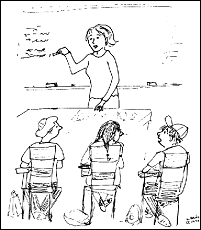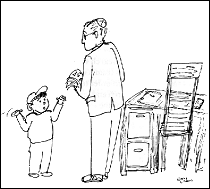- Home
- Play & Learn Home
- Online Enrichment
- Experience Modern Israel
- Israel It's Complicated
- Jewish and Me
- Jewish Holidays Jewish Values
- Jewish Values in Genesis and Jewish Values in Exodus
- Min Ha’aretz
- Our Place in the Universe
- Simply Seder
- The Prophets: Speaking Out for Justice
- Making T'filah Meaningful
- Make, Create, Celebrate
- Yom Haatzmaut Resources
- Hebrew Apps
- About The OLC
- What is the OLC?
- Introduction
- Get Started
- Resources
- OLC Content
- Parent Materials
- See My OLC Classes
- Store
THE ROLE OF THE TEXTBOOK
Maximize your students' use of their textbook by properly introducing it to them early in the semester.

You may be reluctant to spend valuable class time on procedural matters like how to use a textbook. There is so much you want to cover and so little time available. But investing the time at the beginning of the year makes for better learning. Your students will come to appreciate the authority of their book and how it can help them find answers to their questions. An orientation to tables of contents and indices will speed up their ability to locate material. By making students aware of subject headings, key words, or significant proper nouns within a chapter, you will help them to develop the skimming and scanning skills which all good students need. Time spent on process now will buy you time as the semester unfolds.
-
Explain to your students why you chose this book or why it works for this course. Some things you might want to include are the following:
-
The author's scholarly reputation or experience as a teacher in religious schools.
-
Visuals and graphics: e.g., eye-catching maps; archival photographs in history books as opposed to artists' impressions in Bible textbooks.
-
Readability: e.g., the aptness of the vocabulary for the students' grade level; typeface; amount of print on the page.
-
The book's fit with what they have learned before or what they will learn later on. For example, when introducing a history book that follows a year of Bible instruction, it helps to remind students that the Bible contains the stories of the first Jewish families and that later Jewish history picks up the narrative thread where the Bible leaves off.
-
-
Let students know if they will be reading selections from the textbook or the entire book, or if you plan to go through most of the book but not finish it completely.
-
Will you be adding other materials?
-
When and why?
-
For what purpose?
-
-
If the book has special features, now is the time to familiarize your class with them.
-
Do the authors use a certain typeface or design elements (e.g., boxes) for key ideas or concepts?
-
Do they rely on different colored inks to present subthemes within the chapter?
-
Show the students how to use tables of contents, tables of illustrations, and indices. Explain how these tables will help them find material more quickly, making them more efficient learners in any school setting.
-
-
Point out the date of publication.
-
What does this mean? Is the book timely? For example, in a Jewish history textbook printed before 1993, the accord between Israel and the PLO would not be mentioned. You might ask students to look up Yasir Arafat in the index and search the text to find a discussion of the peace agreement.
-
Where can students go to supplement the information in their textbook? This is the place to discuss newspapers and magazines; other books; eyewitness accounts; diaries; radio, television, and other non-book media. Explain whether you plan to use such sources during the year. You may wish to photocopy articles from newspapers and magazines and distribute them to your students. Encounters with objects as well as texts amplify a textbook. Reading about Yom HaAtzmaut is significantly enhanced if students examine souvenirs from trips to Israel, like coins and stamps, or Israeli products sold in the United States such as Jaffa oranges and cosmetics made from Dead Sea minerals. The implicit message you are communicating is that Jewish learning is ongoing, taking place anywhere and at anytime.
-
-
You may want to try one or more introductory exercises to get your students acquainted with their textbook.
-
Ask them to find a certain illustration or a chapter heading.
-
Have your students find three people listed in the index. Which one has the most written about him or her? Ask them to speculate as to why.
-
When you first give the textbook to the students, instruct them to look only at the cover (or perhaps at the cover and the table of contents). Ask them to write what they think the book is about on a piece of paper. Collect these papers, seal them in an envelope, and open them in the middle of the year.
-
Use the table of contents as an informal "pretest " to determine what the students already know.
-
 But this is a Hebrew after-school class!" |
Before you start class, you will need to determine how you will be using your textbook: for homework or for classwork. That determination will help you structure the way you teach your course.
If your school has a tradition of requiring occasional homework assignments, you have more flexibility in planning your course. Share your expectations with students and parents.
-
If you will be assigning homework, let your students know about it early on.
-
If you will be assigning homework, you are more likely to get parental support if you inform them as well. Prepare a letter that gives an overview of your course, including the use of the textbook for homework. Co-opt parents as allies in the educational process. If students get to keep their books when the class is over, you might want to point out that textbooks help to build a home reference library of Judaica. A sample letter can be found on page 23.

Be sensitive to the needs of students whose parents are divorced. A number of your students may be spending weekdays with one parent and weekends with another. Many public and private schools deal with this issue by providing copies of textbooks for each custodial parent. If your school has a book fee, discuss with your education director the option of having divorced parents buy multiple copies.
Whether you use your textbook for homework or not, do not require parents to buy a book for their child and then make no use of it. Parents are justifiably angry if textbooks are purchased and then not used.

